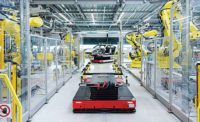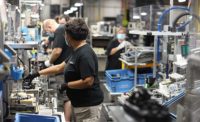In the circus world, tightrope walking requires incredible balance and finesse. One wrong move can have dire consequences. Optimizing workflow on an assembly line is not as dangerous, but it requires a similar set of skills.
Effective balancing minimizes waste and ensures that production lines run efficiently. However, line balancing means different things to different manufacturers. The term also depends on variables such as the type of product being assembled and takt times.
“Line balancing is a term used to explain the process of adjusting labor on manufacturing lines in lean organizations to match takt time based upon the rate of demand,” says Art Smalley, president of the Art of Lean Inc., and a former engineer at Toyota Motor Corp. “It means to balance the amount of labor on the production line to the demand rate of the customer.
“Line balancing connects the amount of labor to the production rate of demand in a precise manner via standardized work,” explains Smalley. “Supervisors at Toyota, for example, have to work with team leaders and team members to adjust manpower based upon calculations involving takt time and standardized work charts. This avoids not having enough [operators] on the production line when demand increases or excess labor on the line when demand decreases.”
“On a manual assembly line, balancing ensures that each production operation has approximately the same amount of time associated with it so that operators can work in sequence,” adds Quarterman Lee, president of Strategos Inc., and an expert on plant layout. “Everything has to be synchronized to operate efficiently.”
Imbalance Creates Waste
Line balancing is an important part of lean manufacturing initiatives, because imbalance creates waste.
“Imbalance will create a lot of work in process (WIP) and idle operators,” warns Drew Locher, managing director of Change Management Associates. “Line balancing is part of heijunka, which is the art of leveling production. This enables production to efficiently meet customer demands while avoiding batching. It results in minimum inventories, capital costs, manpower and production lead time through the whole value stream.
“Whenever demand varies, you have to rebalance,” says Locher. “That’s especially true in any type of build-to-order environment. Some lines need to be rebalanced every shift. For instance, this is quite common in the door and window manufacturing industry.”
“When team members eliminate waste in their processes through kaizens, the result we get is several processes with spots of idle time in each of them,” notes Sammy Obara, president of the Honsha Group. “Team members tend to either fill that time with non-value added work or slow the pace of their cycle time.
“Through line balancing, it is possible to actualize the gains into the bottom line,” explains Obara, who spent three years studying lean manufacturing principles in Toyota City, Japan, and another 10 years applying it at Toyota assembly plants in Brazil, Venezuela and the United States. “You actualize gains by redeploying people toward other value-added activities, to solve problems, to do kaizens, or to replace individuals who retired or left the company.
“If you don’t balance the line and leave all team members working with their increasingly amounts of idle time, you will have a line running at the same cost, but with less working content,” claims Obara. “One common practice in lean is the elimination of waste in all processes, constantly, which creates idle time across processes. Leadership must actualize those individual gains.”
Continuous Flow
Lean production is all about establishing continuous flow, from the acquisition of raw materials to the delivery of the final product to the customer. This concept is best captured in the famous mantra of Taiichi Ohno, the father of the Toyota Production System: “Flow where you can, pull when you cannot.”
“Creating flow within a factory starts in the downstream ‘pacemaker’ process, such as final assembly,” says Jeffrey Miller, P.E., president of Productivity Engineering Services LLC. “This is the most critical segment, since it’s closest to your external customer and sets the tempo for the entire stream.
“Line balancing is important, because it helps to achieve the lean goal of continuous flow,” explains Miller. “Imagine walking into a factory with an assembly line that’s supposed to manufacture a certain number of jobs in an hour. If the line is poorly balanced, some stations may become overwhelmed with work while others have idle time, leading to bottlenecks and delays. This can cause a build-up of WIP at one station, while another station may run out of parts or materials to work on.
“As a result, the flow of the line is disrupted, with some stations working at a slow pace while others work quickly, causing intermittent and erratic flow through the facility,” Miller points out. “This can lead to a decrease in overall productivity, as well as an increase in errors and defects, due to the rushed work and lack of consistency in the production process.
“Additionally, poor line balancing can cause an increase in inventory levels, as the ‘easy’ stations are overproducing and the bottleneck stations fall further and further behind,” adds Miller. “[There’s also] valuable floor space consumed by the excess inventory waiting to be processed.”
To avoid these issues and ensure success, it’s important to have well-balanced production lines that maintains a smooth, consistent flow of components, materials and work through an assembly plant.
“In traditional batch-model assembly lines, products are built in large quantities,” says Miller. “For example, Model A might be produced for one week, followed by two weeks for Model B and three weeks for Model C. This process requires the entire line to changeover whenever switching models, leading to inefficiencies and waste.
“The varying work content of different models requires a dedicated line balance for each,” explains Miller. “This method of production not only increases finished goods inventory, but also results in piles of WIP inventory and, consequently, high inventory carrying costs. Additionally, it protracts lead times and negatively impacts customer service.”
In contrast, a lean manufacturing initiative employs a mixed-model assembly line that is balanced to build different models simultaneously without changeovers. The production mix is leveled according to customer demand. So, for example, the line might produce one unit of Model A, followed by two units of Model B and three units of Model C, and then repeat the sequence.
“This continuous flow approach requires either stocking all part numbers line-side or implementing material sequencing and kitting systems,” says Miller. “The payoffs of this approach include the ability to quickly respond to customer orders with minimal lead time, while holding little finished goods and WIP inventory.”
Mistakes to Avoid
One of the biggest line balancing mistakes that engineers make is not accounting for enough flexibility.
“Manufacturing lines need to be designed in such a way as to allow for this practice to occur,” says Smalley. “There needs to be some flexibility in the equipment, layout, material presentation and operator work space to allow for different levels of staffing to occur.”
“It’s important to build in flexibility,” adds Locher. “You should be able to accommodate for line stoppages and disturbances. And, you also have to design to the slowest process step, accounting for variation in people, parts and processes.
“When you have a lot of product variation, you need to buffer for it in your line design,” explains Locher. “That’s why low-mix, high-volume assembly lines tend to be easier to balance than high-mix, low-volume lines.
“Typically, U-shaped cells give you the most flexibility,” says Locher. “They enable the same operator to move around and do both the first step and the last step in the line. But, it’s not always practical. It often depends on the type of product being assembled, plus the size and configuration of production equipment.”
Strategos’ Lee believes manufacturing engineers should also consider creating more assembly cells. “Smaller, more focused lines or multiple assembly workcells often provide better results [than traditional assembly lines],” he points out. “Cells and smaller lines also reduce demand variation, and reduce both finished goods and WIP inventory.
“Line balancing is more difficult with long, linear lines commonly used in automotive and appliance assembly,” notes Lee. “Workcells make it easier to self-balance, because operators can easily move around and help each other out.”
Another mistake that engineers make is balancing assembly lines according to current cycle times.
“Given that balancing a line requires the extra effort of creating standardized work documents, training, validating and all the stress that comes with changes, it is a waste of opportunity to balance a line without first eliminating as much waste as possible,” claims Darril Wilburn, a partner in the Honsha Group. “First, lean out cycle times. Then, use them to create standardized work. Then, finally, balance the line.”
Engineers also sometimes make the mistake of balancing instead of improving assembly processes.
“When an assembly station is overloaded compared to the rest of a line, the first step should be to improve its part presentation, fixturing, tooling and internal sequencing,” says Michel Baudin, a partner at the Takt Times Group and the author of Lean Assembly (CRC Press). “Once you have done it with an assembly team at all the stations within the line segment it is responsible for, you rebalance the work between stations.
“Management is tempted to rebalance instead of improving based on the assumption that individual tasks have ‘already been optimized,’” explains Baudin. “[They are reluctant] to dig into the details as needed to actually improve them.”
Yamazuki Charts
According to Baudin, Yamazumi charts are a simple tool that can aid line balancing initiatives. The terms means “mountain stacking,” as in building a stacked bar from the times for all the tasks performed at a workstation.
“The X-axis is a sequence of stations along a line,” explains Baudin. “The Y-axis is time, with a line across at the takt time, representing the maximum height of the stacked bars.”
“After a monthly takt time is set, the production team can then line up each operation by number on a board on the horizontal axis and the takt time on the vertical axis,” adds Smalley. “The amount of work content—value-added time elements and waste elements, such as walk time or wait time—are indicated in each stacked bar chart.
“Under the support of the team leader, the work is moved around as needed to balance the line for the number of operators,” notes Smalley. “Work elements are shifted as possible to allow for different labor configurations.”
“Yamazumi charts are a visual way of showing how work content is distributed along processes,” says Obara. “When work content of a production line is displayed in columns, by team member, and with a breakdown of the smaller steps performed by that team member, it is easier to visualize who has more workload, who has less, who is running over the takt time and who has capacity to absorb other tasks. Line balancing becomes much easier to perform.”









